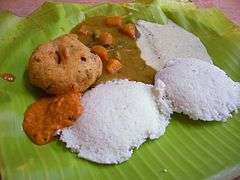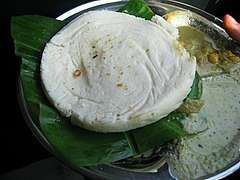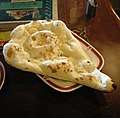Idli
Idli or idly (![]()
| Alternative names | Idly |
|---|---|
| Course | Breakfast & Dinner |
| Place of origin | Indian subcontinent |
| Region or state | South India |
| Associated national cuisine | India, Singapore, Sri Lanka, Malaysia, Indonesia |
| Serving temperature | Hot with a condiment such as sambar or chutney |
| Main ingredients | Black lentils (de-husked), rice |
| Variations | Button idli, tatte idli, sanna, sambar idli, rava idli |
Idli has several variations, including rava idli, which is made from semolina. Regional variants include sanna of Konkan.
History
A precursor of the modern idli is mentioned in several ancient Indian works. Vaddaradhane, a 920 CE Kannada language work by Shivakotiacharya mentions "iddalige", prepared only from a black gram batter. Chavundaraya II, the author of the earliest available Kannada encyclopedia, Lokopakara (c. 1025 CE), describes the preparation of this food by soaking black gram in buttermilk, ground to a fine paste, and mixed with the clear water of curd and spices.[1] The Western Chalukya king and scholar Someshwara III, reigning in the area now called Karnataka, included an idli recipe in his encyclopedia, Manasollasa (1130 CE). This Sanskrit-language work describes the food as iḍḍarikā. In Karnataka, the Idli in 1235 CE is described as being 'light, like coins of high value', which is not suggestive of a rice base.[2] The food prepared using this recipe is now called uddina idli in Karnataka.
The recipe mentioned in these ancient Indian works leaves out three key aspects of the modern idli recipe: the use of rice (not just black gram), the long fermentation of the mix, and the steaming for fluffiness. The references to the modern recipe appear in the Indian works only after 1250 CE. Food historian K. T. Achaya speculates that the modern idli recipe might have originated in present-day Indonesia, which has a long tradition of fermented food. According to him, the cooks employed by the Hindu kings of the Indianised kingdoms might have invented the steamed idli there, and brought the recipe back to India during 800-1200 CE.[3][4] Achaya mentioned an Indonesian dish called "kedli", which according to him, was like an idli.[5][3] However, Janaki Lenin was unable to find any recipe for an Indonesian dish by this name.[6]
Some Gujarati historians believe that it was Saurashtrian textile merchants who introduced idli to South India during the 10th and 12th centuries. There are even claims that a mix of rice and black gram ground together and later steamed to form cakes had its origins in Gujarat.[7] The Gujarati work Varṇaka Samuccaya (1520 CE) mentions idli as idari, and also mentions its local adaption idada (a non-fermented version of dhokla).[8]
The earliest extant Tamil work to mention idli (as itali) is Maccapuranam, dated to the 17th century.[9][10]In 2015, Chennai-based Idli caterer Eniyavan started celebrating 30 March as the "World Idli Day".[11]
Preparation
| Nutritional value per 1 piece (30 gm) | |
|---|---|
| Energy | 167 kJ (40 kcal) |
7.89 g | |
| Dietary fiber | 1.5 g |
0.19 g | |
| Saturated | 0.037 g |
| Monounsaturated | 0.035 g |
| Polyunsaturated | 0.043 g |
1.91 g | |
| Minerals | Quantity %DV† |
| Potassium | 1% 63 mg |
| Sodium | 14% 207 mg |
| |
| †Percentages are roughly approximated using US recommendations for adults. Source: [12] | |
To make Idli, four parts uncooked rice (Idli rice or parboiled rice) to one part whole white lentil (black gram, Vigna mungo) are soaked separately for at least four hours to six hours or overnight. Optionally spices such as fenugreek seeds can be added at the time of soaking for additional flavour. Once done soaking, the lentils are ground to a fine paste and the rice is separately coarsely ground, then they are combined. Next, the mixture is left to ferment overnight during which its volume will more than double. After fermentation some of the batter may be kept as a starter culture for the next batch. The finished idli batter is put into greased moulds of an idli tray or "tree" for steaming. The perforated molds allow the idlis to be cooked evenly. The tree holds the trays above the level of boiling water in a pot, and the pot is covered until the idlis are done (about 10–25 minutes, depending on size). A more traditional method is to use leaves instead of moulds.[13]
- Making idlis
 Key Ingredients used are Rice and Black gram
Key Ingredients used are Rice and Black gram- Idli batter
- Idli mold
- Batter poured into the mold
- Several molds stacked over another
- Idli steaming in cooker
- Cooked idli
- Molds removed from cooker
- Idlis ready to eat
Serving
Since plain idlis are mild in taste, a condiment is considered essential. Idlis are often served with sambar but this varies greatly by region and personal taste. Idlis are also frequently served with chutneys (coconut based), kaara chutney (onion based) or Spicy Fish Curries. The dry spice mixture podi is convenient while travelling.
- Idlis
 Idli and medu vada served with sambar, coconut chutney, and red chutneys on banana leaf
Idli and medu vada served with sambar, coconut chutney, and red chutneys on banana leaf- Idli and vada served with separate sambar and chutney
.jpg) Idli with sambar
Idli with sambar.jpg) Idlis with ghee, ginger pickle and coconut chutney
Idlis with ghee, ginger pickle and coconut chutney
Variations
With the emigration of south Indians and Sri Lankans throughout the region and world, many variations on idli have been created in addition to the almost countless local variations. Hard-to-get ingredients and differing cooking customs have required changes in both ingredients and methods. Parboiled rice can reduce the soaking time considerably. Store-bought ground rice or cream of rice may also be used.[14] Similarly, semolina or cream of wheat may be used for preparing rava idli (wheat idli).[15] Dahi (yogurt) may be added to provide the sour flavor for unfermented batters. Prepackaged mixes allow for almost instant idlis.[16]
In addition to or instead of fenugreek other spices may be used such as mustard seeds, chili peppers, cumin, coriander, ginger, etc.[17] Sugar may be added to make them sweet instead of savory. Idli may also be stuffed with a filling of potato, beans, carrot and masala.[18] Leftover idlis can be cut-up or crushed and sautéed for a dish called idli upma.[19] You can even prepare dahi idli by combining curd and idli together and then tempering the dish. Rather than a stovetop steamer, microwave and automatic electric idli steamers are available with convenient non-stick coating. Batter preparation using a manual rocking rock grinder can be replaced by electric grinders or blenders (mixies). Many restaurants have also come up with fusion recipes of Idlis as idly manchurian, idly fry, chilly idly, stuffed idly and a lot of different ideas.
 Tatte idli, a plate sized variant of Idli from Karnataka
Tatte idli, a plate sized variant of Idli from Karnataka- Mini Sambar Idli, mini idlis floating in sambar as served in Tamil Nadu
.jpg)
- Muday idli is a Mangalorean variant of idli.
.jpg) Rave idli (Sooji idli) is a specialty of Karnataka
Rave idli (Sooji idli) is a specialty of Karnataka
Batter fermentation mechanism
Fermentation of idli batter results in both leavening caused by the generation of carbon dioxide as well as an increase in acidity. This fermentation is performed by lactic acid bacteria especially the heterofermantative strain Leuconostoc mesenteroides and the homofermantative strain Enterococcus faecalis (formerly classified as Streptococcus faecalis). Heterofermantative lactic acid bacteria such as L. mesenteroides generate both lactic acid as well as carbon dioxide whereas homofermantative lactic acid bacteria only generate lactic acid.
Both L. mesenteroides and E. faecalis are predominantly delivered to the batter by the black gram. Both strains start multiplying while the grains are soaking and continue to do so after grinding.
L. mesenteroides tolerates high concentrations of salt unlike most other bacteria. Hence the salt in the batter and the ongoing generation of lactic acid both suppress the growth of other undesirable micro-organisms.[20][21]
See also
- Bánh bò
- Chwee kueh
- Cuisine of Karnataka
- List of Indian breads
- List of steamed foods
- Sanna (dish)
- Serabi
- White sugar sponge cake
- Puttu
References
- Edward R. Farnworth 2003, p. 11.
- K. T. Achaya 1994, p. 90.
- K.T. Achaya (1 November 2003). The Story of Our Food. Universities Press. pp. 80–. ISBN 978-81-7371-293-7.
- D. Balasubramanian (21 October 2004). "Changes in the Indian menu over the ages". The Hindu.
- "Idli saga: A study into the origin of the South Indian dish".
- Lenin, Janaki (30 March 2012). "A tale of two sambhars" – via www.thehindu.com.
- "Celebrating the moon-faced health food on World Idli Day". OnManorama. Retrieved 4 April 2020.
- Achyut Yagnik; Suchitra Seth (24 August 2005). Shaping Of Modern Gujarat. Penguin Books Limited. p. 24. ISBN 978-81-8475-185-7.
- Vikram Doctor (28 April 2007). "Idli saga: A study into the origin of the South Indian dish". Economic Times. Retrieved 25 August 2014.
- K.T. Achaya (5 March 2009). The Illustrated Foods of India. OUP India. ISBN 978-0-19-569844-2.
- "World Idli Day 2018: Here's The Intriguing Story Behind This Delicious Day". NDTV. 30 March 2018.
- "Calories in Idli and Nutrition Facts". www.fatsecret.co.in.
- "Idlis in jackfruit leaves". Aayi's Recipes. 2006. Retrieved 14 October 2014.
- "Idli using Cream of Rice". Edibly Asian. Retrieved 14 October 2014.
- Geeta, Seth. "Rava Idli : (Cream of wheat or sooji idli)". North India Cooking. Retrieved 14 October 2014.
- "instant idli mix". Tarla Dalal. Sanjay & Co. Retrieved 14 October 2014.
- Rachana, Gorikapudi (2012). "Fenugreek Leaves Idli". SPICY CURRIES. Retrieved 14 October 2014.
- "Stuffed Idli". Spicy Tasty. 2013. Retrieved 14 October 2014.
- "Idli Upma Recipe-Recipe with Leftover idlis". Padhu's Kitchen. 2012. Retrieved 14 October 2014.
- VEEN, A. G.; HACKLER, L. ROSS; STEINKRAUS, K. H.; MUKHERJEE, S. K. (28 June 2008). "Nutritive Quality of Idli, a Fermented Food of India". Journal of Food Science. 32 (3): 339–341. doi:10.1111/j.1365-2621.1967.tb01326_32_3.x. ISSN 0022-1147.
- Council, National Research (1 January 1992). Applications of Biotechnology in Traditional Fermented Foods. doi:10.17226/1939. ISBN 978-0-309-04685-5. PMID 25121339.
Bibliography
- K. T. Achaya (12 May 1994). Indian Food: A Historical Companion. Oxford University Press, USA. ISBN 978-0-19-563448-8.CS1 maint: ref=harv (link)
- Devi, Yamuna (1987). Lord Krishna's Cuisine: The Art of Indian Vegetarian Cooking, Dutton. ISBN 0-525-24564-2.
- Edward R. Farnworth (2003). Handbook of Fermented Functional Foods. CRC Press. ISBN 978-0-8493-1372-1.CS1 maint: ref=harv (link)
- Jaffrey, Madhur (1988). A Taste of India, Atheneum. ISBN 0-689-70726-6
- Rau, Santha Rama (1969). The Cooking of India, Time-Life Books.


